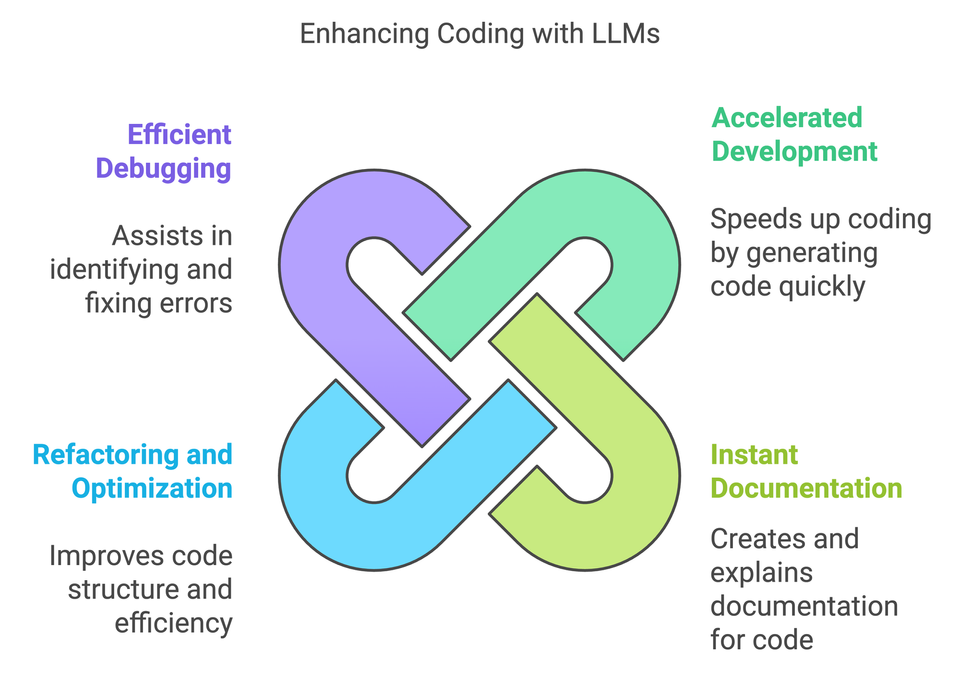Mastering Code Development with Large Language Models (LLMs)

Mastering Code Development with Large Language Models (LLMs)
In recent years, Large Language Models (LLMs) such as OpenAI’s GPT and Anthropic’s Claude have transformed the coding landscape. These advanced AI tools have revolutionized software development, making coding more accessible, efficient, and streamlined. From generating boilerplate code to refactoring, debugging, and even offering design recommendations, LLMs are reshaping the way developers work and innovate.
Understanding the Capabilities of LLMs
Large Language Models are trained on extensive datasets encompassing code snippets, documentation, forums, and industry best practices. This vast and diverse training enables them to:
- Accelerate Development: By instantly generating accurate code snippets, developers save substantial time on repetitive or boilerplate coding tasks.
- Enhance Documentation: LLMs can swiftly explain complex code blocks or entire modules, creating clear and precise documentation that improves readability and maintainability.
- Optimize Refactoring: Leveraging LLMs for refactoring allows developers to adopt best practices without needing deep expertise in every coding standard or pattern.
- Facilitate Debugging: When encountering errors, LLMs efficiently suggest probable fixes, provide step-by-step debugging instructions, and guide developers toward root cause analysis.
These strengths position LLMs as indispensable tools for individual developers and small teams, significantly boosting productivity and capability.
Navigating Limitations in Complex Projects
Despite their impressive capabilities, LLMs face inherent limitations, particularly as project complexity scales:
- Contextual Memory Constraints: LLMs often struggle to maintain and interpret context across extensive codebases or multi-file projects, leading to inconsistencies or errors in suggestions.
- Complex Relationship Handling: Understanding intricate interdependencies between files or modules remains challenging, limiting their effectiveness in highly interconnected systems.
- Risk of Hallucinations: Occasionally, LLMs generate plausible-sounding but incorrect or irrelevant suggestions, known as hallucinations, which require careful vetting by developers.
To mitigate these challenges, developers must adopt structured approaches and strategies that enhance LLM interaction.
Best Practices for Leveraging LLMs
To effectively integrate LLMs into your development workflow, particularly for larger and complex projects, follow these best practices:
1. Maintain Clear Code Structure:
- Modularize your codebase into smaller, self-contained functions and modules, making it easier for LLMs to understand context and generate accurate suggestions.
- Adhere strictly to naming conventions and clear documentation, providing additional contextual clues for LLMs.
2. Optimize Prompt Engineering:
- Craft clear and concise prompts that explicitly state your intent, providing LLMs with sufficient contextual information for accurate responses.
- Incrementally build prompts, progressively narrowing down the problem scope to avoid overwhelming the model.
3. Manage Context Explicitly:
- Regularly summarize or restate context within prompts when working across multiple files or modules.
- Provide reference snippets or key points explicitly within prompts to reinforce accurate context.
4. Iterative Verification:
- Continuously verify outputs from LLMs through rigorous code reviews, unit testing, and validation processes to ensure accuracy and reliability.
- Incorporate automated testing frameworks to quickly catch and rectify inaccuracies or hallucinations introduced by the model.
5. Adopt Collaborative Workflows:
- Use version control systems and collaborative platforms to track code changes systematically, making it easier to revert or correct errors suggested by LLMs.
- Leverage pair programming or collaborative reviews involving team members to cross-validate suggestions from LLMs.
Overcoming Common Challenges
Addressing common pitfalls with thoughtful strategies helps maximize LLM benefits:
- Handling Hallucinations: Verify generated code through automated tests and manual reviews.
- Managing Complexity: Break down larger problems into smaller tasks to maintain clarity for both the developer and the LLM.
- Scaling Context Management: Periodically restate and summarize project goals, constraints, and prior context explicitly in interactions with the LLM.
Conclusion
Large Language Models offer powerful capabilities that significantly enhance developer productivity and creativity. By understanding their strengths and addressing their limitations through structured approaches and best practices, developers can effectively harness LLMs, even in complex and sizable projects. Embracing a nuanced approach that balances LLM capabilities with human oversight ensures not only greater efficiency but also maintains high standards of accuracy and reliability in software development.